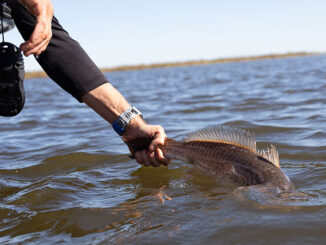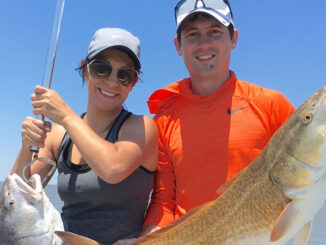Want to catch limits of reds on artificials and bait? Buras is the place to go.
In his duties as editor of BASSMASTER magazine, James Hall travels the country and fishes the most-iconic bass habitats. He regularly rubs elbows and shares deck space with legends like Dance, Swindle and VanDam.
But when Hall heads southwest from his Birmingham home and crosses the Magnolia State to fish the rich, dynamic waters of south Louisiana, it’s never bass on his brain. It isn’t speckled trout, either.
Hall is a redfish nut who can’t get enough of the aggressive strikes, intense pulls and surface eddies made by powerful tails.
That could have been bad news for him late last September, if Chris Macaluso and Capt. Todd Seither weren’t such nice guys. Seither, a guide for Cajun Fishing Adventures in Buras, had been on a good trout run — not smoking-hot, like it would be a few weeks later, but good enough to put anywhere from 35 to 50 in the boat each day, while throwing nothing but soft plastics.
That was music to Macaluso’s ears. Like many native Louisianians, he thinks speckled trout look down their noses at the piscatorial peasants from the hallowed peak of the underwater kingdom. He would loved to have spent the day setting the hook and watching early autumn trout erupt through the surface in gill-rattling frenzies.
But, alas, Hall wanted to chase redfish.
Redfish on the brain
The two anglers are good enough friends that Macaluso could have told him to take his redfish and do something very unnatural with them, but Hall was down as Macaluso’s guest, so he felt some level of duty to entertain him.
Redfish it would be.
Seither was prepared for either option. So after launching at “Riverside,” the most absurdly dilapidated ramp anywhere in North America, and crossing the Mississippi River to get to the waters of Bay Auguste, Seither announced that he had brought dead shrimp to attract more bites from the spot-tails.
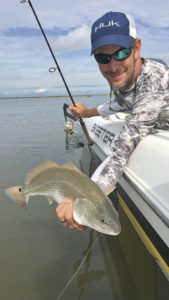
Hall wasn’t prepared to stoop to that level. He threw a spinnerbait with a gold Colorado blade and caught a handful of fish, but before long, he was reaching into the shrimp bucket in Seither’s ice chest.
Good thing he did, because then the fish went absolutely bananas. Everywhere the anglers went, they caught redfish after redfish, moving only when a particular stretch of shoreline played out.
It was as good as redfish action gets, but it was anything but abnormal for this time of year, according to Seither.
“In September and October, it’s consistent limits before 10 a.m. every day,” he said.
Where to go
Seither and his fellow guides target bull reds in nearshore waters for about three weeks after the August full moon, but when that peters out, they move to the edges of the marsh, where the slot-sized redfish feast on white shrimp that are being sucked out with each falling tide.
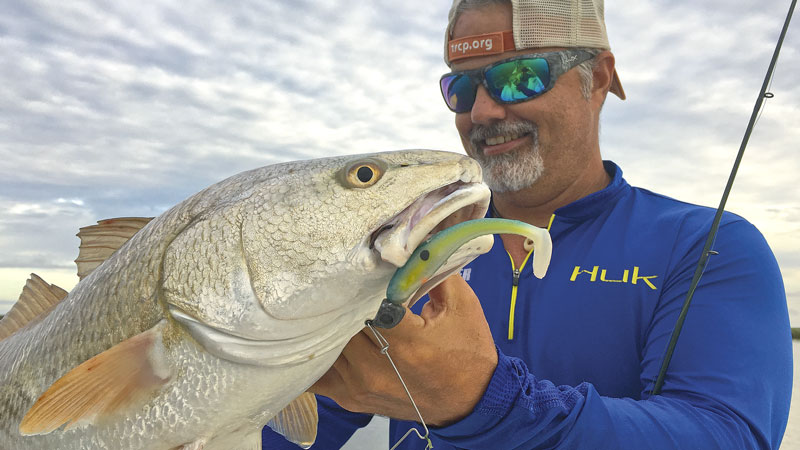
“The shrimp just showed up recently,” he said during the trip with Macaluso and Hall. “We’ve had the pogies and mullet in here, but the shrimp just really showed up in numbers in the last week or so.
“The reds haven’t really gotten deep, deep into the marsh yet. They’re closer to the outside edge.”
What he catches them on this time of year depends on his clients. Some are hard-core artificial anglers who would use natural bait only with a gun to their heads. Others, like Hall, are a bit more flexible.
“For the most part, it’s soft-plastics under a cork, tipping them with dead shrimp,” Seither said. “If you go early, you can catch them on spinnerbaits, but once that water warms up, the fish slow down a little bit.”
The Oreo effect
To demonstrate how the fish feel in those warmer water temperatures, Seither used an analogy that involves America’s favorite cookie.
“If you come home from work exhausted, sit down in your recliner, get settled in, and your wife pulls out a pack of Oreos, but she leaves them on the counter, they’re probably just going to sit there,” he said. “You’re too tired to get up to get them.
“But if she brings them to the little table next to the recliner, you’re going to mow them down.”
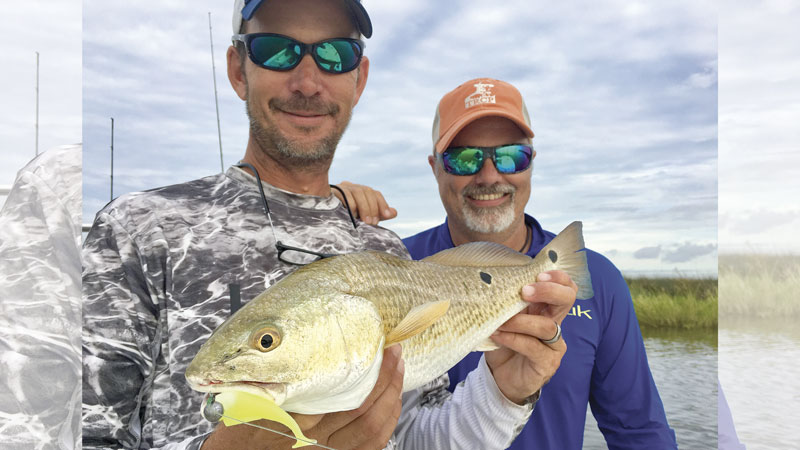
In their lethargic mid-day state, redfish may not chase a spinnerbait, but they can’t resist a tasty piece of shrimp dangled in front of their faces, Seither said.
Where to cast
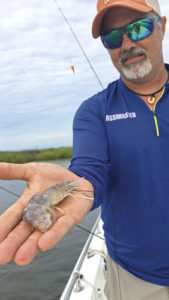
Where he throws that bait depends on the day and conditions. If winds aren’t too extreme, or he can find a lee shoreline, he’ll work the small bays. If the winds are up, however, he’ll focus on ponds with underwater grass.
“Submerged vegetation definitely helps,” he said during last September’s trip. “Where I’ve been catching most of my fish is absolutely loaded with grass. It’s a quicker bite in areas with grass.”
In those ponds, Seither said he uses the submerged grass patches as shorelines, casting close enough but not too close. That, of course, can present problems for inexperienced anglers.
“On windy days and cloudy days, it’s hard to see the edges of that grass, but you’ve got to kind of feel it out,” he said. “You want to work the edge of the grass patches, not too far and, obviously, not in the middle of it.
“Sometimes, I have to feel it out and tell my clients where to cast. As a general rule, you look for calm water with no ripples. That’s where the grass is.”
You don’t have to go far
Sometimes, however, Seither doesn’t even have to run as far as the small bays to the east. After launching at Riverside, he’ll burn less than a gallon of gas before putting his clients on their limits of redfish by fishing the Mississippi River itself.
“They always want to get in the river because it’s a lot cooler,” Seither said. “Everything wants to get in the river: the bait, the fish, everything. If the river is low, low, low, I’ll stay in there and won’t leave it all day. It’s awesome when it’s like that.
“But if it isn’t low, I like it at least 6 feet, because it pushes everything out and concentrates them (in the bays and ponds). You just have to run a little farther to catch them.”
Last year, the river was unseasonably high from mid-September through October. Seither said the fish were thick in Big Muddy for about a week in early September before getting pushed out by rising waters.
So they were quite concentrated in the bays and ponds when Hall showed up, and that made him a happy man.
Finding speckled trout gets easier this month
Although James Hall couldn’t care less about them, speckled trout are also thick in the waters east of Buras this time of year. Capt. Todd Seither had a nice run last September.
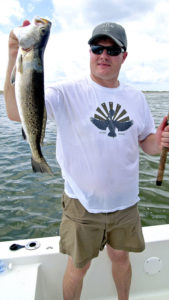
“They weren’t big, but they went into the ice chest,” he said. “There were several 15-, 16-inch fish mixed in, but the majority were around 13 (inches).”
To catch them, Seither threw shrimp poboy-colored Z-Man Swimming Trout Tricks under corks off points in the same general areas he took Hall to catch redfish.
In October, finding the fish becomes even easier, however.
“We haven’t had any flocks of birds yet, to where you know it’s a trout bite,” he said late last September. “But it’ll start happening any day. When you see that you can throw whatever’s on the line; it doesn’t matter. They’ll hit it all.
“But I like tight-lining under birds because the bigger fish are usually underneath the smaller ones.”
